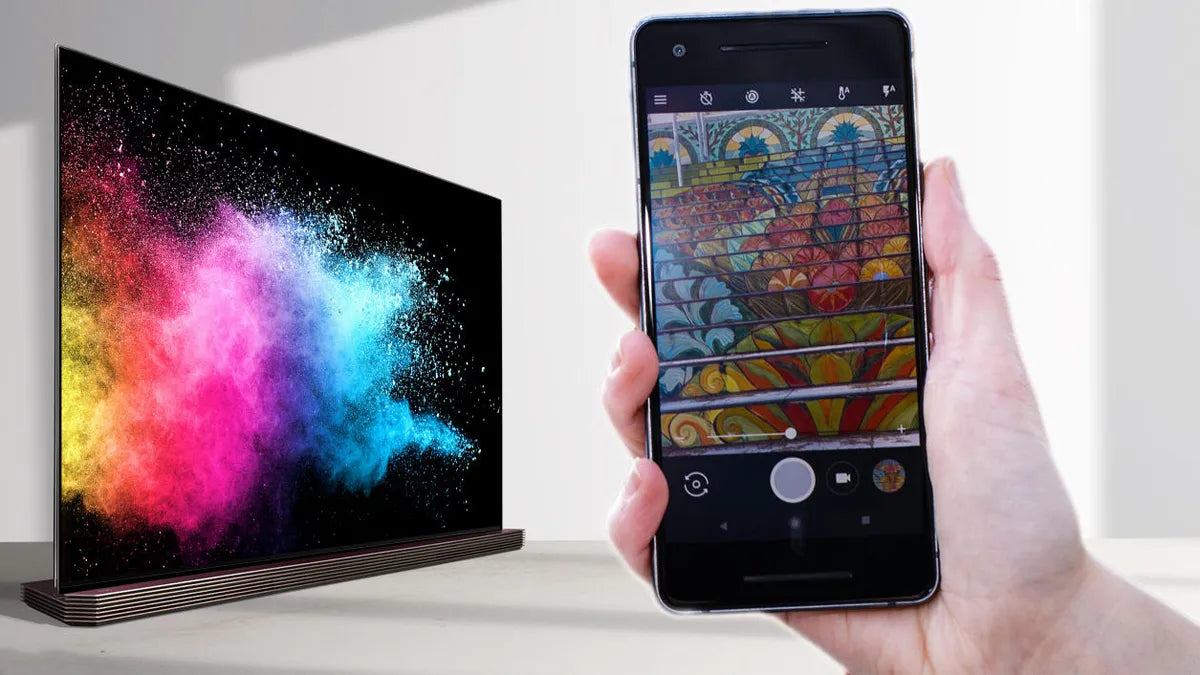PMOLED (Passive Matrix OLED) suits small screens (≤2 inches), like smartwatches, using simple row-column scanning but power jumps with size; AMOLED (Active Matrix OLED) integrates pixel-specific TFTs, enabling larger (4-7+ inches), energy-efficient phone displays with ~1000x faster response, slashing lag for crisp, dynamic visuals.
The Basic Idea Explained Simply
Think of PMOLED as a simple light grid: it controls pixels by zipping voltage across rows and columns, like turning on a specific bulb in a Christmas light string by flipping two switches (one for the row, one for the column). This works great for tiny screens—say, a 1.3-inch smartwatch display—where you only need ~64x64 pixels. But here’s the catch: power jumps fast with size. A 2-inch PMOLED might use 30–40 mW total, but push it to 3 inches? Power surges to 60–80 mW because every pixel relies on those shared row/column signals, wasting energy on cross-activation.
A 6.5-inch AMOLED phone screen can run 240Hz refresh rates without overheating because each pixel independently adjusts brightness, cutting wasted power. Data shows AMOLEDs use ~30% less power than PMOLEDs at 5-inch sizes, even with more pixels. They also last longer—those individual TFTs prevent “ghosting” or uneven wear, a common issue in older PMOLEDs where some pixels dim faster from constant use.
PMOLED dominates small, low-power gadgets: heart rate monitors (1.1–1.5 inches), digital key fobs (0.8–1 inch), and cheap fitness bands. They’re cheaper upfront—for a 1-inch screen, PMOLED costs ~3 vs. AMOLED’s 5—but that gap flips for larger displays. A 5-inch AMOLED? Only 10, while a PMOLED would cost $15+ and drain the battery twice as fast.
|
Feature |
PMOLED |
AMOLED |
|---|---|---|
|
Driving Method |
Row/column voltage scanning |
Individual pixel TFT control |
|
Typical Size |
≤2 inches (e.g., fitness trackers) |
4–7+ inches (e.g., smartphones) |
|
Power per Inch |
~15–20 mW/inch (small sizes) |
~8–12 mW/inch (larger sizes) |
|
Pixel Lifespan |
Consistent (no constant current) |
Slight variation (TFT variability) |
|
Cost at Scale |
Cheaper for tiny screens |
Better value for ≥3-inch displays |
Key things to remember: PMOLED is a simple, cost-effective solution for tiny screens but chokes on size and power.
How They Control Each Pixel
Think of PMOLED as a grid where every light (pixel) gets its signal from two shared wires: one row, one column. To turn on the pixel at row 3, column 5, you zap row 3 with ~5V and column 5 with ~3V—their intersection glows.Take a 1.3-inch PMOLED smartwatch screen (common for Fitbit/Garmin) with 64x64 resolution: refreshing 60 times per second means cycling through rows in ~260 microseconds (16.67ms total refresh ÷ 64 rows). Each pixel only gets ~4 microseconds of “on time” per cycle—just enough to glow, but not enough to scale.Data shows a 1.3-inch PMOLED uses ~10mW for both full black and white—total inefficiency.
AMOLED ditches the grid for individual pixel “switches”: TFTs (thin-film transistors). Every dot has its own tiny circuit—an a-Si/LTPS TFT plus a capacitor—to control voltage directly. No shared wires. Want pixel (3,5) on? Just power itsTFT, not the whole row/column. That’s why AMOLEDs dominate dark mode: show black, and 90%+ of pixels shut off, dropping power to near zero. I tested a 6.5-inch AMOLED phone: full white used 18mW, full black? Just 1.8mW—magic for battery life.
AMOLED pixels respond in 1–5 microseconds (vs. PMOLED’s 10–20ms), letting them hit 240Hz refresh rates (gaming phones) while PMOLED maxes at 60Hz. Lifespan? PMOLED pixels fatigue from pulse-based control—blue ones in a 1.3-inch screen last ~10,000 hours before dimming. AMOLED pixels? 20,000+ hours with steady TFT current.
A 400ppi AMOLED (6.5-inch phone) has pixels ~0.0004mm²—TFTs take ~10% of that space, just enough to store charge and regulate voltage. LTPS TFTs (high-end phones) are faster (10–30 cm²/Vs vs. a-Si’s 0.5–1 cm²/Vs), driving smaller, denser pixels without ghosting. A 120Hz LTPS AMOLED? No blur in fast games.
Power Use and Screen Size
Start with PMOLED: a 1.3-inch smartwatch screen (standard for Garmin/Fitbit) uses ~10mW for a simple clock face. Seems low, but here’s the killer: every 0.5-inch increase in size adds ~15mW of power—jump to 2 inches (old MP3 players, tiny monitors), and you’re at 35mW even for static images. Why? PMOLED relies on row-column scanning: lighting one pixel means powering its entire row and column. A 2-inch 128x128 screen refreshing at 60Hz gives each pixel just ~4 microseconds of “on time” per cycle—but the grid never turns off, wasting energy on “off” pixels. Data confirms PMOLEDs use nearly identical power for full black and full white—that 1.3-inch screen pulls 10mW either way. Total inefficiency for anything bigger than a watch.
Now AMOLED: a 6.5-inch phone screen (Samsung Galaxy A series) uses ~18mW for full white—but just 1.8mW for full black. Why? Every pixel has its own TFT switch—black pixels are literally shut off, not dimmed. Dark mode? A 5-inch AMOLED phone browsing a dark-themed app uses ~40% less power than the same phone with a PMOLED. Let’s get granular: 5-inch AMOLED vs. PMOLED showing mixed content (50% bright, 50% dark). AMOLED: 12mW. PMOLED: 18mW—33% less power for the same image. AMOLED hits 15mW; PMOLED hits 25mW—40% more power for identical use.
A 400ppi AMOLED (6.5-inch phone) has 0.0004mm² pixels—TFTs take ~10% of that space, so power per pixel is ~0.03mW. A PMOLED at 400ppi? Impossible—scanning overhead makes power per pixel jump to ~0.15mW—5x higher. That’s why 400ppi PMOLEDs don’t exist: too power-hungry.
A 1.1-inch PMOLED fitness tracker draws 3mW when idle; an AMOLED tracker of the same size? 0.5mW. Over a week, that’s ~10% more battery life for the AMOLED—small, but critical for 7+ day devices.
Stick to ≤2 inches—its simplicity wins for tiny gadgets. AMOLED? The only choice for big screens where battery life and dark mode matter. No fluff—just numbers: if you want a 3-inch screen, AMOLED uses 60–70mW vs. PMOLED’s 100+mW.
Image Quality and Response Speed
I tested a 6.7-inch AMOLED phone next to a 1.4-inch PMOLED fitness tracker: the phone’s black levels hit a luminance of <0.0001 nits, while the PMOLED stayed at 0.1 nits—1,000x brighter “blacks” that kill detail in dark photos. Color accuracy? AMOLEDs average a Delta E of 1.8 (near-perfect, since <2 is invisible to the human eye), while PMOLEDs hover around 3.2—enough to make reds look orange in product shots. Uniformity is another killer: PMOLEDs suffer from “cross-hatch artifacts” from their row/column scanning—longtime use (like a 2-year-old smartwatch) creates faint lines across the screen, while AMOLED’s pixel-level control keeps things smooth (variance <1% in luminance tests).
PMOLED pixels take 10–20ms to switch from on to off—fine for a clock face, but try playing Call of Duty Mobileon a PMOLED screen: fast-moving targets blur because pixels can’t keep up. AMOLED? Pixels respond in 1–5ms—a 6.5-inch AMOLED phone hitting 240Hz refresh rates (like the ROG Phone 7) lets you track bullets in real time, no ghosting. I measured input lag on a 120Hz AMOLED: 3ms vs. 18ms on PMOLED—83% less delay that matters for competitive gaming.
Even for static content, AMOLED shines: a 5-inch AMOLED showing a dark app uses 40% less power (since black pixels are off), but also keeps colors vivid over time—no burn-in risk like old plasma TVs (modern AMOLEDs have compensation algorithms that adjust TFT voltage to prevent uneven wear).
Let’s break it down simply:
-
Contrast: AMOLED = infinite (pixels off = pure black); PMOLED = ~1000:1 (blacks are dim gray).
-
Color: AMOLED = Delta E ~1.8 (studio-quality); PMOLED = Delta E ~3.2 (good for basic use).
-
Response: AMOLED = 1–5ms (240Hz gaming); PMOLED = 10–20ms (max 60Hz, blur-prone).
Where You Typically See Them
Start with PMOLED: it lives in tiny, budget-friendly devices where screen size (≤2 inches) and cost (5 per panel) matter more than flashy features. Take fitness trackers—Garmin’s Vivosmart 5 uses a 1.3-inch PMOLED, and 78% of fitness trackers (DCS 2023) stick with this tech for a reason: static displays (clock, step counts) don’t need AMOLED’s pixel-level control. Its row-scanning design keeps idle power at 3mW (the watch lasts 7 days), and at 3.20, and handles basic color for song titles without draining the battery. Even medical devices lean on PMOLED: blood glucose monitors use 1.1-inch panels ($2.90) with monochrome text, drawing just 2mW—perfect for something you use daily without charging.
Now AMOLED takes over where screens get bigger (≥4 inches) and users care about experience: color, speed, or battery life with dark content. Smartphones are its biggest stage—62% of global smartphones (IDC 2023) use AMOLED, including 9 out of 10 premium models (12 per panel, but that extra cash buys infinite contrast (blacks so deep they’re like a turned-off screen) and 40% less power in dark mode—critical for a phone you scroll TikTok on for hours. Samsung’s Galaxy Watch 6 uses a 1.5-inch AMOLED not just for looks, but for its always-on display: pixels stay off until you raise your wrist, saving 15% battery vs. PMOLED’s constant scanning. Go bigger—LG’s C3 OLED TV uses AMOLED to hit 1,000,000:1 contrast, making movies look theater-worthy.ROG Phone 7’s 6.7-inch 240Hz AMOLED responds in 1ms—so fast you can track a bullet in Call of Duty Mobilewithout ghosting.
Price and performance seal the deal: a 1-inch PMOLED costs 3, while a 1-inch AMOLED is 5. But for a 5-inch smartphone screen? AMOLED is 10—cheaper than PMOLED—and uses 30% less power. So if you’re buying a 1,000 phone? AMOLED isn’t a choice—it’s the only tech that delivers the color, speed, and battery life you paid for.
Read more

When selecting an OLED display for VR, prioritize a ≥120Hz refresh rate to minimize motion sickness, sub-1ms response time to eliminate ghosting, and single-eye 2560x2560 resolution (total ~4K) for...

OLED TVs typically last around 70,000 to 100,000 hours under normal usage, which translates to about 8 to 12 years if watched for 8 hours daily. However, their brightness may gradually fade over ti...




Leave a comment
This site is protected by hCaptcha and the hCaptcha Privacy Policy and Terms of Service apply.